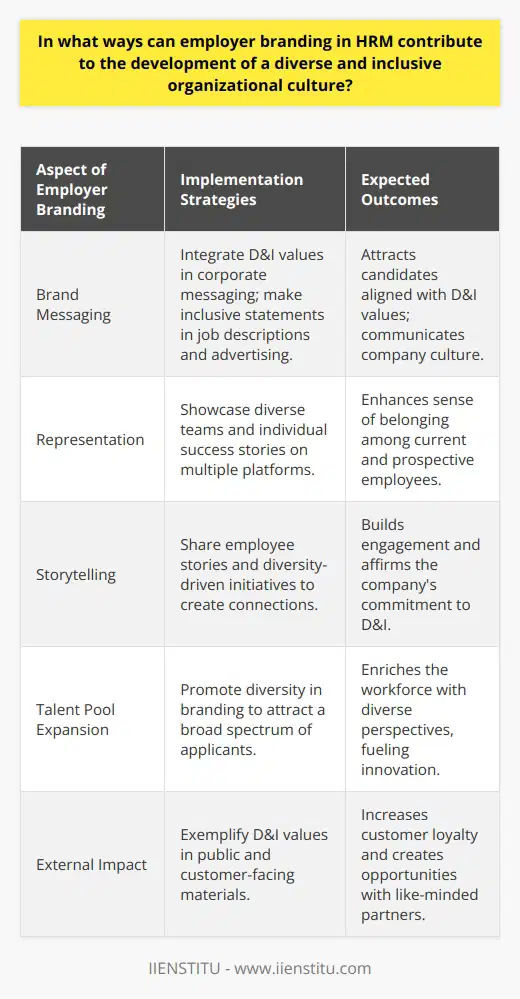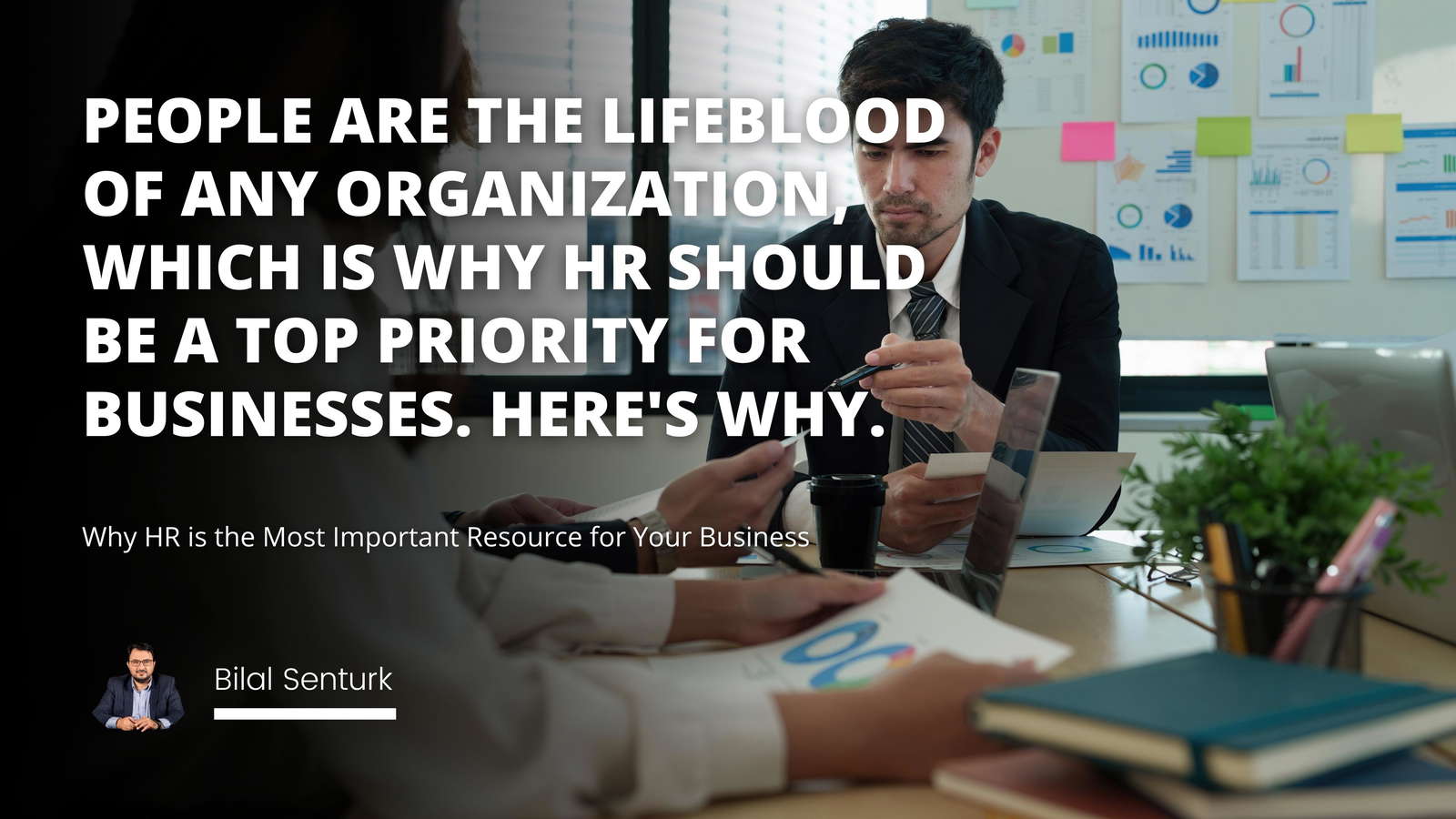
Employer Branding is an essential process in Human Resource Management that involves creating a positive public image of an organization as an employer to attract, retain, and motivate the best employees. In addition, organizations that invest in Employer Branding will likely reap financial benefits, such as improved recruitment efficiency, cost savings, and increased Employee Retention and productivity.
The success of employer branding depends on factors such as clarity, consistency, and credibility. However, it can be seen as an asset for organizations, as it can help create a positive public image, attract the best talent, and increase employee engagement and motivation.
Introduction
Definition of Employer Branding
The increasing importance of Employer Branding
Benefits of Employer Branding
Financial Benefits
Introduction
Employer branding has become increasingly important in the modern business environment. Employer branding is creating an attractive and desirable public image of an organization as an employer, which helps attract, retain, and motivate the best employees for the organization.
It is a relatively new concept in Human Resource Management, but its importance and application have grown significantly in the last decade. Organizations build their employer branding systematically, which results in financial benefits, increased attractiveness to prospective employees, and the creation of a suitable and effective organizational culture.
Related Course: Hr Online Course
Benefits of Employer Branding
Organizations that invest in employer branding are likely to reap several financial benefits. These include improved recruitment efficiency, cost savings, and increased Employee Retention and productivity. In addition, organizations with strong employer brands are more likely to attract the best talent in their respective industries, as prospective employees are more likely to be attracted to organizations with an established public image.
Organizations that successfully create a strong employer brand will likely make a suitable and effective organizational culture. This is because employer branding creates a positive public image of the organization as an employer, which can help develop a sense of pride and loyalty among employees. This, in turn, can lead to increased employee engagement and motivation, resulting in improved performance.
Characteristics of Employer Branding
The success of employer branding depends on several factors. First and foremost, the employer brand must be clear. The organization must be able to communicate its message concisely and effectively. Finally, the organization must clearly explain its values, mission, and goals.
The employer brand must also be consistent. The organization must maintain the same message and values over time. This will help to ensure that the employer brand remains strong and recognizable.
Finally, the employer brand must be credible. This means that the organization must be able to back up its message with evidence and facts. This will help to ensure that the employer brand does not become diluted or lost in the noise.
Employer Branding as an Asset
Employer branding can be seen as an asset for organizations. This is because it can help create a positive public image, attracting the best talent and increasing employee engagement and motivation.
Furthermore, employer branding can also help create a suitable and effective organizational culture, leading to improved performance.
Conclusion
In conclusion, employer branding has become increasingly important in the modern business environment. As a result, organizations that invest in employer branding will likely reap several financial benefits, increase attractiveness to prospective employees, and create a suitable and effective organizational culture.
The success of employer branding depends on several factors, such as clarity, consistency, and credibility. Finally, employer branding can be seen as an asset for organizations, as it can help create a positive public image and improve performance.
Employer Branding is not an option; it is an essential part of any successful HRM strategy.
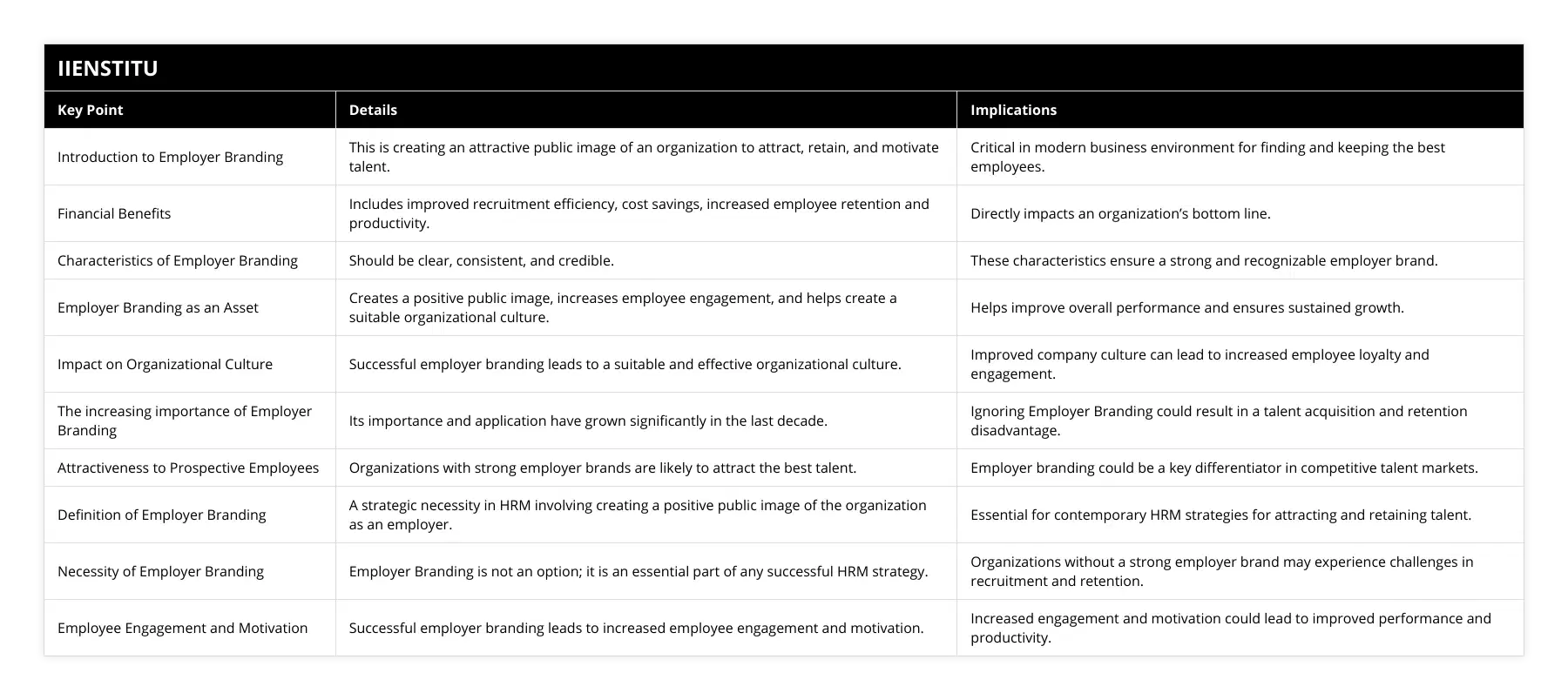
Frequently Asked Questions
What are the benefits of Employer Branding for an organization?
Employer branding has become a crucial part of the recruitment process and a critical factor in the success of an organization. Employer branding creates an attractive and positive perception of an organization as an employer, which can be realized through various activities, such as creating positive content about the organization, offering competitive benefits and salary, or even leveraging social media. In this blog post, we will discuss the importance of employer branding and its benefits for an organization.
Employer branding can help an organization attract the best talent, as it promotes the organization as an employer of choice. When an organization cultivates a positive image as an employer, it will be more likely to attract qualified candidates looking for a job that offers stability and a positive working environment.
Furthermore, a strong employer brand can also help an organization retain its employees, as employees who feel strongly connected to their employer are more likely to remain with the organization. Moreover, employer branding can help an organization differentiate itself from its competitors. By creating a unique image as an employer, an organization can stand out from its competitors and attract more candidates. Additionally, employer branding can help an organization gain a competitive edge in the recruitment process, as it can help an organization reduce its recruitment costs and time to hire.
Finally, employer branding can help an organization improve employee engagement and productivity. When an organization has a strong employer brand, its employees will be more likely to be engaged and motivated, which can lead to increased productivity. Furthermore, a strong employer brand can help an organization attract and retain the best talent, leading to improved performance and higher profits.
In conclusion, employer branding is a powerful tool to attract and retain the best talent, differentiate itself from its competitors, reduce recruitment costs, and improve employee engagement and productivity. Therefore, employers should prioritize employer branding and make it a part of their recruitment process.
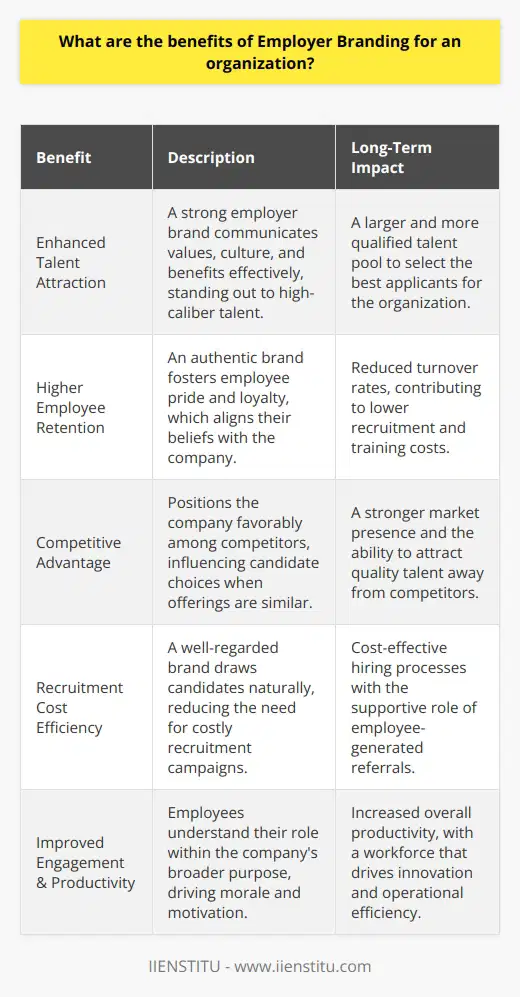
How can an organization create a suitable and effective organizational culture through Employer Branding?
Employer branding is an invaluable tool for organizations intending to create a compelling and suitable organizational culture. Employer branding is defined as the image of an organization as an employer that is created and maintained through marketing techniques and activities. Employer branding enables organizations to differentiate themselves from competitors and attract the right talent.
Organizations can create an influential organizational culture through employer branding by communicating their core values and desired workplace culture to potential employees. This can be done through various marketing activities such as job postings, recruitment campaigns, and employer reviews. Through these activities, organizations can communicate their company values and desired workplace culture to potential employees, allowing them to make informed decisions about their employment.
Employer branding also allows organizations to differentiate themselves from competitors by highlighting their unique advantages, such as employee benefits or training and development opportunities. By highlighting these unique advantages, organizations can attract the most qualified talent.
Organizations can also use employer branding to develop a positive employer-employee relationship. By creating a positive work environment, organizations can ensure that employees feel valued and respected and that they can work productively. This can be done through employee recognition programs, surveys, and feedback.
Finally, employer branding can create a suitable organizational culture by providing a platform for employees to voice their opinions and ideas. Through surveys, feedback forms, and other activities, organizations can ensure that their employees are invested in the organization's success and that their opinions are heard. This can help organizations create a suitable workplace culture conducive to productive and successful work.
In conclusion, employer branding is an invaluable tool for organizations seeking to create a suitable and effective organizational culture. By communicating their core values and desired workplace culture, differentiating themselves from competitors, developing a positive employer-employee relationship, and providing a platform for employees to voice their opinions and ideas, organizations can attract the most qualified talent and create a suitable and effective organizational culture.
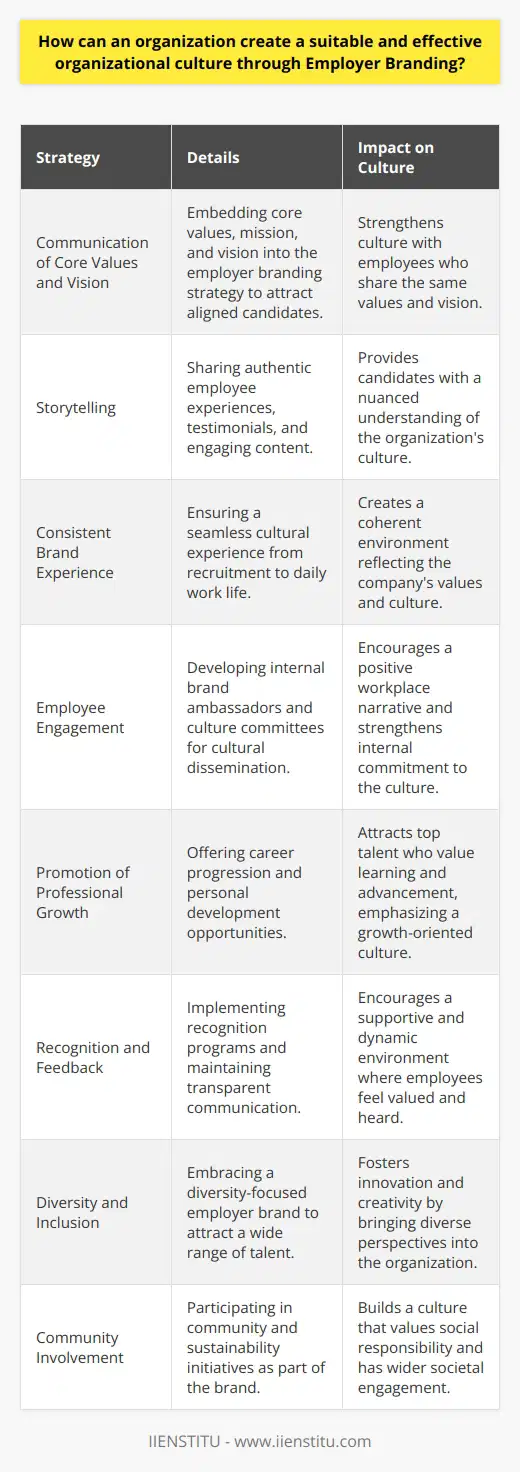
What are the characteristics of an effective Employer Branding strategy?
Employer branding is an essential aspect of an organization's marketing strategy. It is focused on creating and promoting an attractive image of the company in the minds of potential employees. An effective employer branding strategy can help attract and retain talented employees, improve employee engagement and loyalty, and enhance the company's reputation.
There are several key characteristics of an effective employer branding strategy.
First, it should be based on a clear understanding of the company's mission and values. This helps to create a consistent and unified message. It should also be based on a thorough knowledge of the target audience. This includes understanding their needs and expectations from the organization.
Second, the employer branding strategy should be tailored to the target audience. It should be designed to appeal to the target audience and to create an emotional connection. This could include using positive messages and images that resonate with the target audience.
Third, the employer branding strategy should be consistent across all channels. This means that the same message should be used in all forms of communication, including advertising, job postings, and company websites. It should also be consistent in terms of tone and language.
Fourth, the employer branding strategy should be integrated with other aspects of the organization's marketing strategy. For example, it should reinforce the organization's core values and create a cohesive brand image.
Finally, the employer branding strategy should be regularly monitored and evaluated. This will help to ensure that the system is effective and meets the organization's goals. It is also essential to ensure that the strategy is kept up-to-date with changes in the organization and the external environment.
Overall, an effective employer branding strategy is tailored to the target audience, is consistent across all channels, is integrated with other aspects of the organization's marketing strategy, and is regularly monitored and evaluated. By following these characteristics, organizations can create an attractive employer brand and attract and retain talented employees.

What is the strategic role of HRM employer branding in talent acquisition and retention?
Strategic Role of HRM Employer Branding
The strategic role of HRM employer branding in talent acquisition and retention encompasses several key aspects that ensure an organization's continued growth and success. A strong employer brand serves to attract and retain top talent, ultimately contributing to the achievement of business goals and maintaining competitive advantage.
Attracting High-Quality Talent
HRM employer branding plays a crucial role in communicating the organization's core values, culture, and employment opportunities. By presenting the company as an ideal workplace, HR can effectively entice high-quality candidates to apply for open positions. This helps organizations to recruit the best talent available and benefits the organization in the long run through increased productivity and innovation.
Enhanced Employee Engagement
A compelling employer branding enables HRM to foster a strong sense of pride, belonging, and mutual support among employees. This increases employee engagement and contributes to more satisfied workers who are motivated to excel in their roles. As a result, organizations benefit from improved performance and lower turnover rates, translating to reduced recruitment and training costs.
Greater Retention and Increased Loyalty
Well-executed HRM employer branding fosters a positive organizational culture that encourages employees to commit to the company and develop their professional careers. This results in higher retention rates, increased employee loyalty, and reduced attrition costs. Furthermore, a strong employer brand can also diminish the likelihood of top talents being lured away by competitors, particularly in industries that face talent shortages or high employee turnover.
Promoting Employee Referrals
Employees who are proud of their employer's brand are more likely to refer others to join the company. This not only shortens the hiring process but also helps in sourcing quality candidates with a higher likelihood of cultural fit within the organization. As employee referrals are typically more cost-effective than traditional recruitment methods, this can lead to significant cost savings in talent acquisition.
In conclusion, HRM employer branding, when executed effectively, serves as a strategic tool for organizations to attract, recruit, and retain top talent. It holds the power to enhance employee engagement, create a positive organizational culture, and reduce recruiting costs, ultimately contributing to the achievement of business goals and maintaining a competitive edge in the market. Therefore, organizations should prioritize the development of a strong employer brand as part of their strategic HRM initiatives.
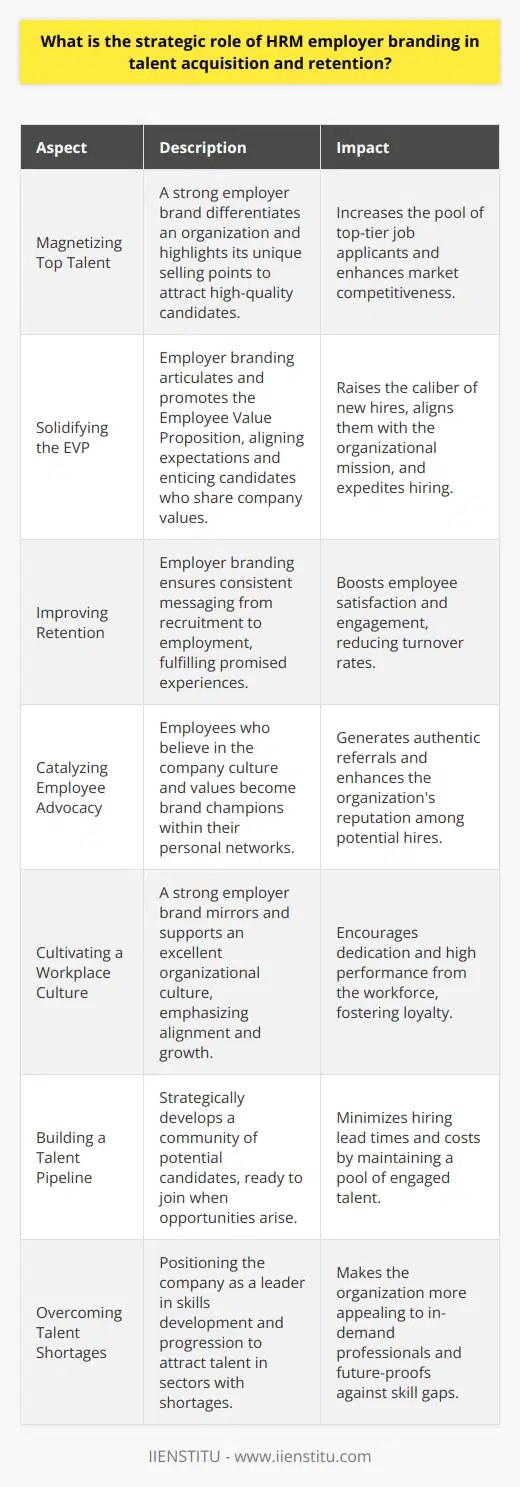
Why is employer branding necessary for enhancing an organization's competitive advantage?
The Significance of Employer Branding
Employer branding plays a crucial role in shaping an organization's competitive advantage. It refers to the company's reputation and value proposition from the perspective of potential and existing employees. By establishing a strong employer brand, organizations can differentiate themselves from competitors, thereby attracting and retaining top talent.
Attracting Talent
In today's fiercely competitive job market, job seekers frequently evaluate potential employers based on their employer brand. When an organization is perceived as a desirable place to work, it is more likely to receive a larger pool of qualified applicants. Consequently, companies with strong employer brands have access to a wider range of skills and experiences, which can provide a significant advantage in a continually evolving business landscape.
Reducing Turnover Rates
A positive employer brand also helps organizations retain valuable employees. As employees develop a strong emotional attachment to the organization, their job satisfaction and commitment to the company's success increase. By fostering a sense of loyalty and belonging, organizations with robust employer brands experience lower employee turnover rates. This reduces the costs associated with recruitment and training, while also maintaining continuity and stability within the team.
Enhancing Employee Motivation
Employees working for organizations with strong employer brands often feel a sense of pride in representing the company. This pride can translate into increased motivation and loyalty, as employees aim to contribute to the organization's success. Higher employee motivation leads to improved productivity and service quality, providing a competitive edge over other companies with less engaged workforces.
Building a Positive Reputation
Lastly, a strong employer brand helps build a positive reputation among customers, investors, and other stakeholders. When a company is recognized for its excellent workplace culture and employee-centric policies, the perception of the organization as a whole improves. This enhanced reputation can have a wide range of benefits, including increased customer trust, stronger partnerships, and potential access to new markets.
In conclusion, creating and maintaining a strong employer brand is essential for organizations seeking to enhance their competitive advantage. By attracting top talent, reducing employee turnover, enhancing motivation, and building a positive reputation, organizations with strong employer branding can position themselves at the forefront of their industries. As the business landscape continues to evolve, the significance of employer branding as a strategic tool should not be underestimated.
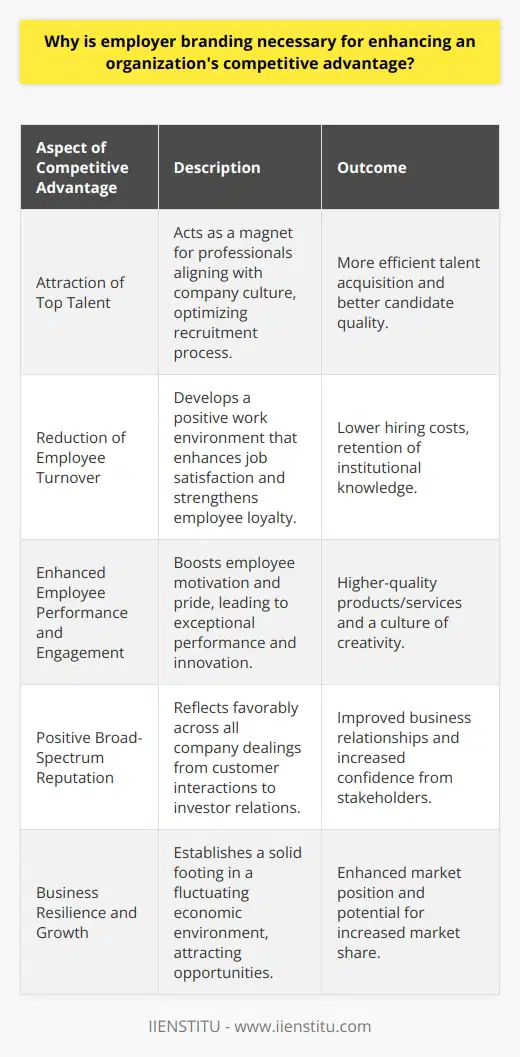
What is the relationship between employer branding in HRM and employee engagement and satisfaction?
**Employer Branding and Its Impact on Employees**
Employer branding in Human Resource Management (HRM) pertains to the reputation and image of an organization with regard to employee relations and workplace culture. A strong employer brand plays a critical role in attracting and retaining top talent, fostering employee engagement, and increasing overall job satisfaction.
**Influence on Employee Engagement**
One aspect of the relationship between employer branding and employee engagement lies in the alignment of organizational values and expectations. A company that effectively communicates its mission, goals, and desired behaviors supports employees in understanding their individual roles within the organization. This, in turn, boosts engagement by fostering a sense of belonging and shared commitment to common objectives.
**Enhancing Employee Satisfaction**
Moreover, employer branding is crucial in promoting a positive workplace environment. Providing development opportunities, implementing fair compensation and reward systems, and fostering a sense of work-life balance contribute to a strong employer brand. As a result, employees feel valued, respected and satisfied with their work and the organization, ultimately improving retention rates and organizational performance.
**Role of HRM in Employer Branding**
The HRM plays an essential function in crafting and implementing employer branding strategies. By refining recruitment processes, emphasizing employee development, and promoting a supportive workplace culture, HRM enables organizations to build an appealing and sustainable employer brand that resonates with current and prospective employees.
**Feedback Mechanisms and Continuous Improvement**
Establishing a feedback loop is crucial for assessing the effectiveness of an organization's employer branding activities. Regular employee surveys and performance reviews help pinpoint areas of improvement and ensure that workplace practices align with the organization's intended employer brand image. This feedback enables HRM to make proactive adjustments to optimize employee engagement and satisfaction.
In conclusion, employer branding in HRM significantly influences employee engagement and satisfaction. Through strategic communication, investment in employee development, and fostering a cohesive workplace culture, organizations can harness the power of employer branding to attract, engage, and retain an empowered workforce.
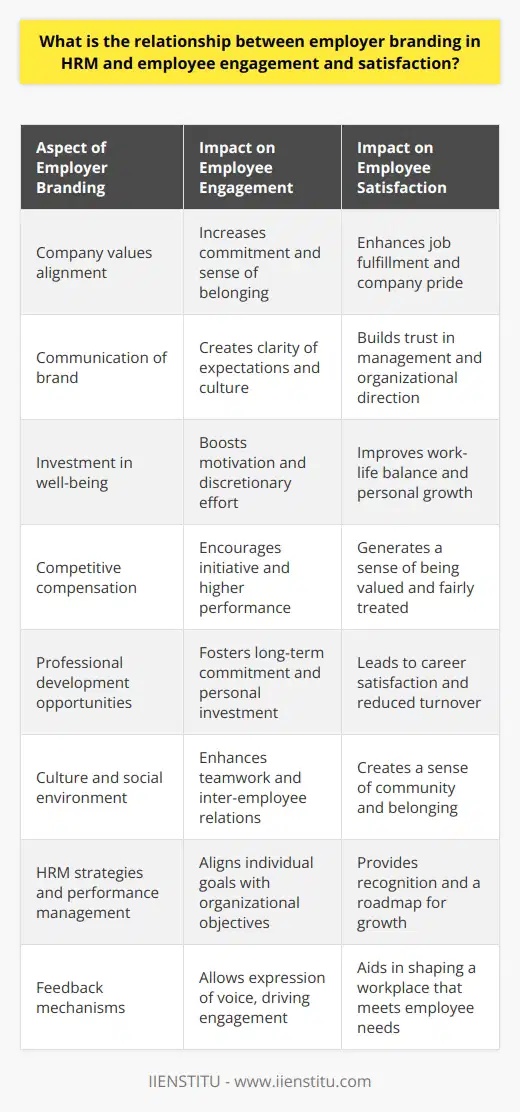
What is the importance of employer branding in HRM in attracting and retaining high-quality employees?
Significance of Employer Branding
Employer branding plays a crucial role in Human Resource Management (HRM) by attracting and retaining top talent within an organization. A strong employer brand sends a clear message of the company's values, culture, and employee experience, which appeals to potential candidates seeking opportunities for growth and development. Moreover, employer branding has become increasingly important in the era of social media and online reviews, where job seekers can research organizations and make informed decisions before applying for a position or accepting an offer.
Enhancing Attraction of High-Quality Employees
A well-defined and consistent employer brand creates interest among high-quality candidates, enticing them to explore opportunities within the organization. A positive brand image aligns with the values and desires of sought-after talent, establishing an emotional connection and increasing the likelihood of candidates accepting offers. Furthermore, a compelling employer brand differentiates the organization from competitors, ensuring that the best candidates are drawn to the company and not its rivals.
Strengthening Retention Efforts
Employer branding is not only vital for attracting high-quality employees but also for retaining them in the long term. A strong brand fosters an environment of trust, loyalty, and commitment among current employees, helping to reduce turnover and ensuring that top talent remains within the organization. By investing in employer branding efforts, organizations create a positive working experience that resonates with employees, promoting employee satisfaction and engagement with the organization's mission and values. In turn, this cultivates a more productive workforce and provides stability for the company.
Promoting Employee Advocacy
A robust employer brand also encourages current employees to become ambassadors for the organization, actively promoting the company to friends, family, and professional networks. When employees feel proud to work for their organization, they recommend it to others, spreading positive word-of-mouth and creating a self-sustaining recruiting engine. As a result, organizations benefit from a wider talent pool to draw from and increased brand awareness, paving the way for long-term success.
In conclusion, the importance of employer branding in HRM lies in its vital role in attracting, retaining, and promoting high-quality employees, ultimately contributing to organizational productivity, stability, and success. By investing in a strong employer brand, organizations set themselves apart from competitors and ensure they remain top of mind for top talent in the competitive job market.
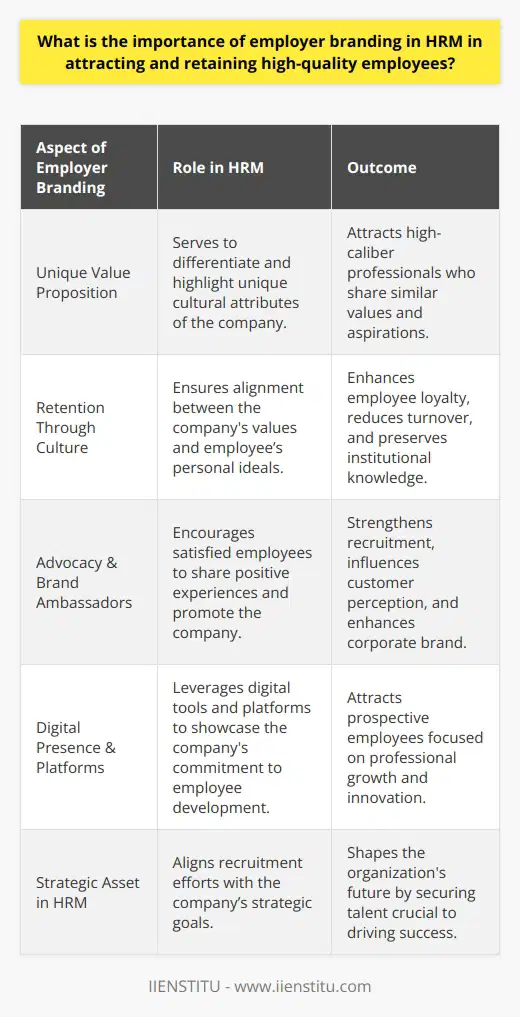
How do employer branding strategies in HRM impact overall organizational performance and productivity?
Significance of Employer Branding in HRM
Employer branding strategies in human resource management (HRM) significantly influence overall organizational performance and productivity. By creating and maintaining a strong employer brand, organizations attract top talent, decrease recruitment costs, and increase retention rates.
Attracting Top Talent
A positive employer brand image enables organizations to entice highly skilled and motivated employees. Candidates seek employment from organizations that showcase their accomplishments, workplace culture, and employee satisfaction. As a result, organizations access a talented workforce that positively contributes to overall performance and productivity.
Decreasing Recruitment Costs
With a strong employer brand, organizations experience lower recruitment expenses. Comprehensive branding strategies promote a company's reputation in the job market, leading to a natural influx of qualified candidates. Thus, companies can lower recruitment costs, including advertising, agency fees, and time spent interviewing, which directly impacts organizational productivity.
Increasing Retention Rates
Employer branding impacts employee retention rates by instilling a sense of pride and loyalty among workers. A reputable employer brand fosters a culture where employees feel engaged, valued, and motivated to contribute to the organization's success. Consequently, employees are more likely to stay with the company, reducing the cost and disruption of employee turnover, and enhancing overall productivity.
Continuous Improvement of the Brand
Organizations that actively monitor and improve their employer brand derive sustained benefits in performance and productivity. Regular assessments and adjustments to branding strategies help organizations stay relevant and adapt to changing market trends. By focusing on continuous improvement, the employer brand progressively contributes to organizations' long-term growth and success.
In conclusion, employer branding strategies in HRM play a crucial role in enhancing overall organizational performance and productivity. By attracting top talent, decreasing recruitment costs, increasing retention rates, and continuously improving the brand, organizations can realize substantial benefits from implementing effective employer branding strategies.
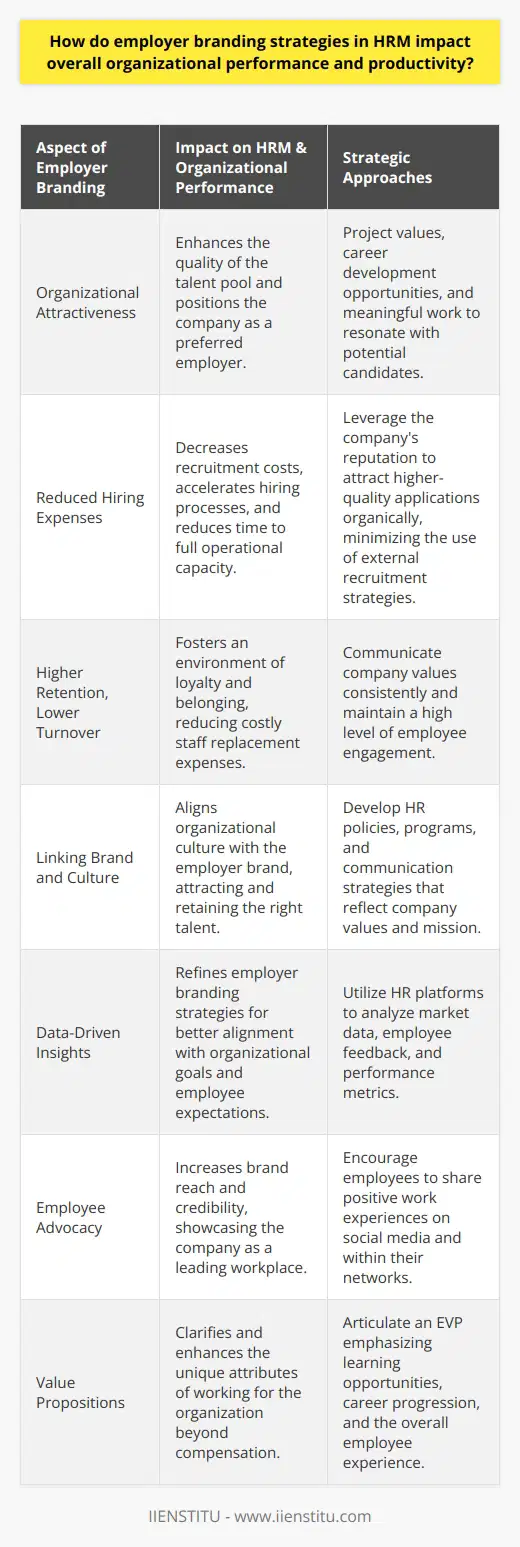
What is the role of leadership in promoting and maintaining a strong employer brand within an organization?
**Leadership and Employer Brand**
The role of leadership in promoting and maintaining a strong employer brand within an organization is multifaceted and crucial for sustained success. Leaders are responsible for establishing and communicating the organization's values, vision, and culture, which directly influence the employer brand.
**Establishing Organizational Values**
First and foremost, leaders need to establish clear organizational values that define the company's identity and differentiate it from competitors. These values guide decision-making processes, shape employee behavior, and communicate to potential employees what the organization stands for. By creating a set of core values, leaders can foster a unique workplace culture that is attractive to top talent and makes employees proud to be part of the organization.
**Communicating Vision and Culture**
Leaders play an essential role in communicating the organization's vision and culture, both internally and externally. By articulating a clear vision and purpose, leaders inspire employees to work towards a common goal and contribute to the overall success of the company. Additionally, an attractive and well-communicated workplace culture has the potential to attract talent, improving the organization's employer brand.
**Role Modeling and Employee Engagement**
It is not enough for leaders to merely establish values and communicate the vision; they must also embody these principles in their everyday actions. Leaders can strengthen the employer brand by acting as role models, adhering to organizational values, and demonstrating the desired behaviors. Engaging with employees and supporting their growth, recognizing their efforts, and providing regular feedback also contribute to creating a positive employer brand.
**Internal and External Promotion**
Finally, leaders should actively promote their organization's employer brand to both internal and external audiences. This can be achieved by sharing success stories, showcasing company culture through social media, and participating in industry events. Internally, leaders must ensure employees are engaged and motivated, further enhancing the company's reputation as an attractive place to work.
In conclusion, the leadership plays a vital role in promoting and maintaining a strong employer brand within an organization through establishing organizational values, communicating vision and culture, acting as role models, and promoting the brand both internally and externally. These efforts create a positive workplace environment that attracts and retains top talent, contributes to the overall success of the organization, and upholds a strong employer brand.
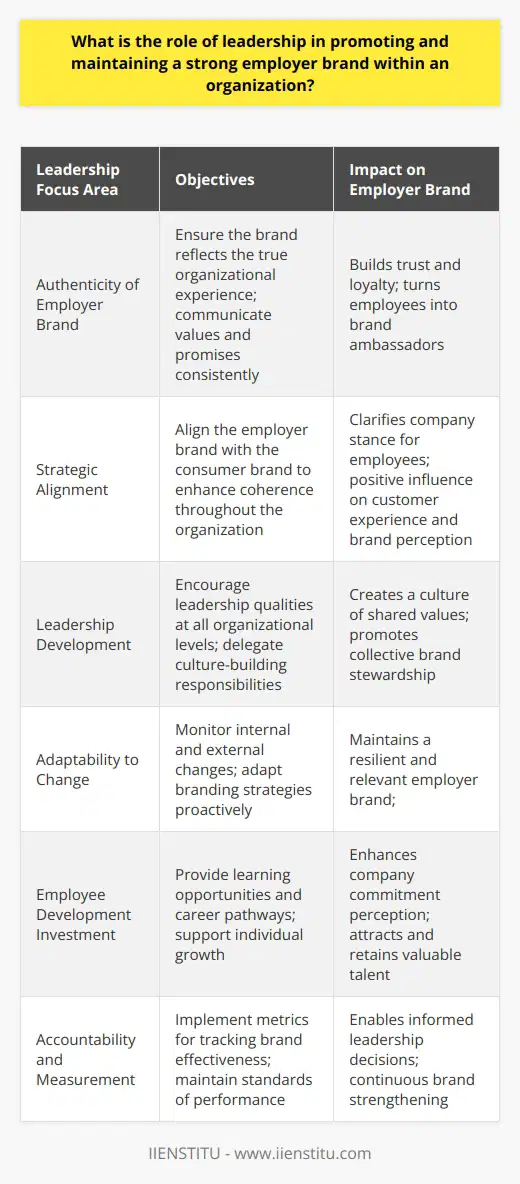
What is the impact of employer branding in HRM on employee motivation and performance?
Employer Branding and Employee Motivation
The role of employer branding in Human Resource Management (HRM) is substantial, especially concerning employee motivation and performance. Employer branding can hinge on a company's reputation, culture, and offered perks. These elements play an integral role in attracting and retaining top talent, thus driving motivation.
Influence on Motivation
Employees tend to perform better in companies that channel positive employer branding. They gain a sense of belonging and validation in seeing their company as a preferable place to work. This favorable perspective fosters job satisfaction, which can inspire high levels of motivation.
Additionally, a strong employer brand may promise possibilities for personal growth and advancement. Employees who view their jobs as stepping stones towards their career progression are likely to stay motivated. They will constantly strive to perform well, being aware that their efforts can spur career advancement.
Impact on Performance
The contribution of employer branding to performance is significant. A strong brand image sends a message of stability and longevity to the workforce. If employees believe in their company's vision and future, they become more committed. The resultant increase in job commitment directly improves performance, as employees are more likely to exert extra effort.
Moreover, employer branding often encompasses the cultivation of a healthy work environment. Such an environment promotes open communication, teamwork, and mutual respect among employees. This harmonious setting often reduces stress and burnout while improving productivity and performance.
In conclusion, employer branding can act as a strategic tool in HRM. It influences employee motivation and performance positively. Therefore, companies should prioritize developing and managing a strong employer brand.
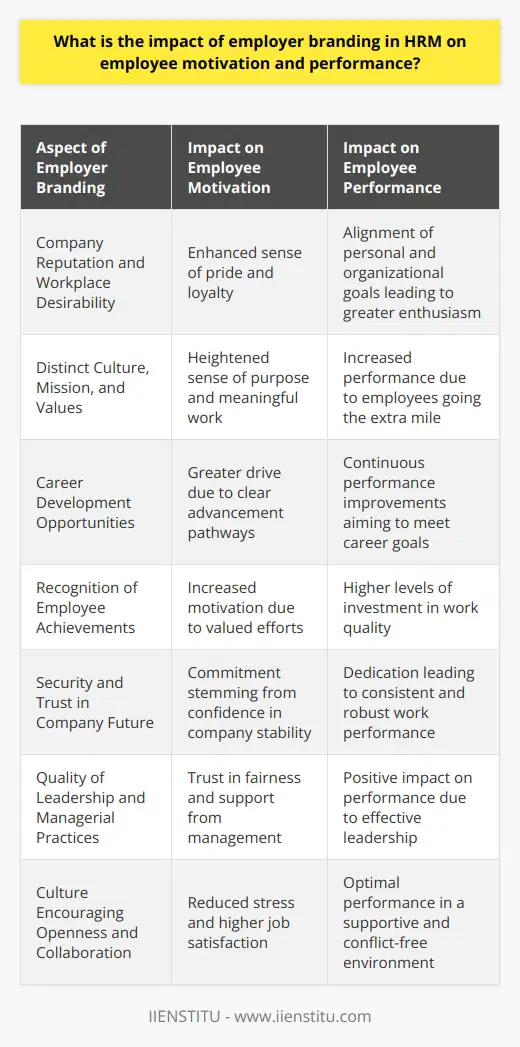
How can HRM effectively measure and evaluate the success of an employer branding strategy?
Establishing Metrics
Effective measurement and evaluation of an employer branding strategy in Human Resource Management (HRM) requires a robust system of metrics.
Quantitative Measures
Quantitative measures are one approach HRM can utilize. These countable metrics may include decrease in turnover rates, rise in internal job applications, and increase in qualified applicants. You can also use the time it takes to fill a vacancy, or even the acceptance rate of job offers.
Social Media Interactions
Monitoring social media interactions is another way HRM can measure success. Track the number of shares, likes, comments, and overall engagement on posts about the company as an employer. This can provide valuable insights into the effectiveness of your employer branding.
Employee Surveys
Direct feedback from employees via surveys is another option. This can help measure the current perception of the company as an employer. Remember to consistently use the same survey system to ensure a reliable comparison over time.
Cost Savings
Lastly, measuring the cost savings from reduced recruitment and training expenses presents another method. The success of an employer branding strategy often leads to reduced hiring costs and lower turnover rates, leading to significant financial savings.
In conclusion, HRM can effectively measure and evaluate the success of an employer branding strategy using a mixture of quantitative data, social media metrics, direct employee feedback, and cost measurements. All of these methods combined facilitate a comprehensive understanding of the strategy’s success.
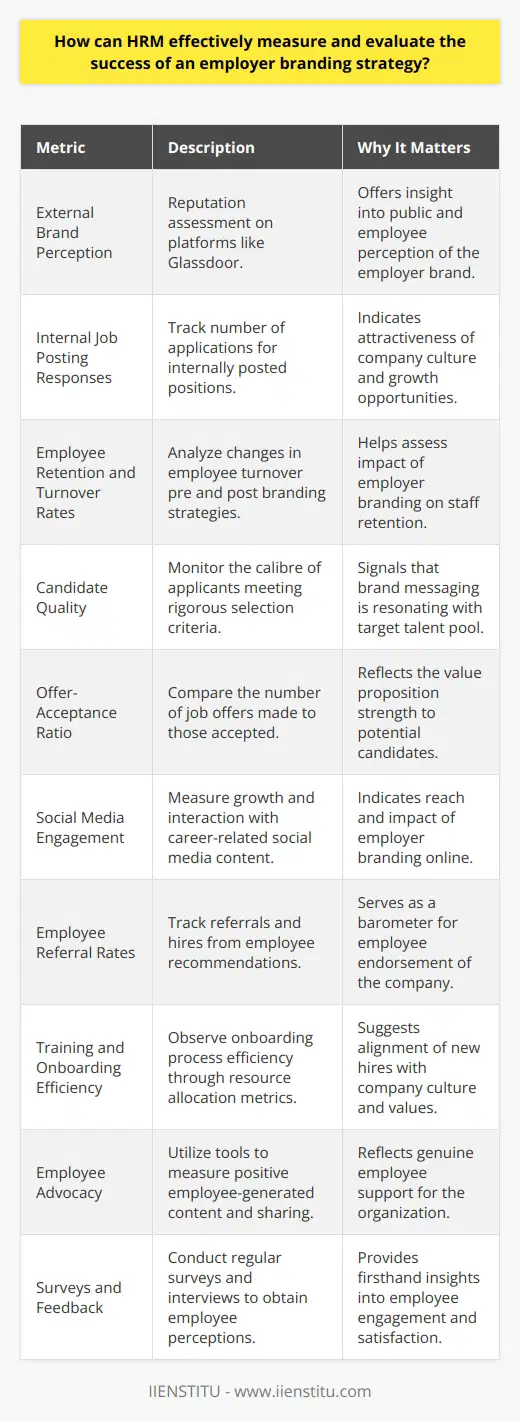
In what ways can employer branding in HRM contribute to the development of a diverse and inclusive organizational culture?
Role of Employer Branding in Promoting Diversity
Employer branding in Human Resource Management (HRM) can significantly contribute to developing a diverse and inclusive culture. An essential way is through showcasing diversity and inclusion (D&I) as an organization's core values. When companies integrate D&I into their employer brand, they set expectations about the kind of workplace they provide. This depicts the organization as an entity that values everyone’s input, irrespective of their background.
Influence of Brand Positioning
A robust brand positioning portrays an organizational culture that welcomes all. Prospective employees are attracted to companies where they can fully express themselves without fear of prejudice or bias. By striving for a diverse workforce, companies not only foster an inclusive culture but also attract talent from a more extensive pool.
Impact on Employee Retention
Employer branding in HRM also affects employee retention. When a business takes a clear stance on diversity and inclusion, and integrates it into their brand, it reinforces an environment of belonging. Employees in such settings are likely to stay longer, which reduces turnover rates and ultimately supports the company's growth.
The Power of a Diverse Employer Branding Strategy
Incorporating diversity into employer branding strategy sends a powerful message to not just potential employees, but also customers, investors, and the public at large. It underscores the organization's commitment to equality and fairness. This brand image offers a competitive advantage to organizations in the labor market.
In conclusion, employer branding in HRM plays a pivotal role in promoting a diverse and inclusive organizational culture. It helps attract talent from diverse backgrounds, retain them and enhances the company's reputation. Implementing these strategies is thus invaluable for any organization committed to diversity and inclusion.
